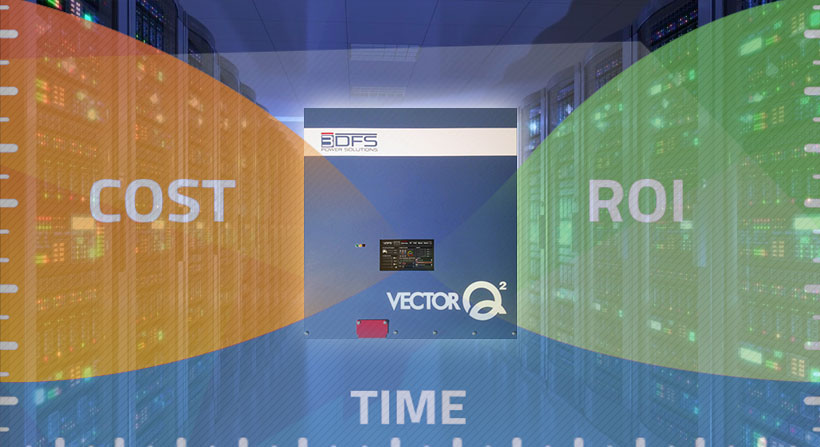
The instant that the VectorQ2 is turned ON you will begin saving power and money. These must be looked at separately because the amount of money you are charged is only partly determined by the amount of power you consume. When and how your Data Center consumes power is factored into how you are charged, i.e. demand charges, kVAR penalties, day and night rates, etc.
Savings on IT equipment through reduced maintenance and replacement costs will be distributed across both capital and operational expenses and will be visible over time.
The return on investment for the VectorQ2 must be considered in three different ways:
Instant Payback
The most immediate payback from the data center perspective is
- Increase in uptime
- Increase in quality of data in both communication and storage
- Near elimination of downtime during power source transitions
- Immediate protection of server aisle from variations in the electricity flow
The VectorQ2 is a computer that constantly cleans and balances the electricity in the server aisle. This automatic protection from fluctuations and distortions will stabilize the server aisle power network, prevent disruption and eliminate the need for human interaction in the power network.
The immediate and sustained benefits result in greater uptime and:
- Maintains lowest possible utility rate during all demand charges
- Eliminates overloading and imbalance in UPS outputs, by providing almost ideal load
- Improves data transmission rate
- Reduces data re-transmission rate
- Decreases error rates in data storage by nulling Neutral currents and significantly reducing Ground currents
- Provides instant availability of energy usage data in details
- Automatic and dynamic impedance matching for the electrical network
- Reduction in heat generated by servers, distribution wiring, switches, fuses and power supplies
- Greenest consumption of electricity possible
- Full row real-time Class B surge protection
- Increased safety of the facilities including by improving the quality of the grounding
Short-Term Return on Investment
Every data center is unique in its setup and operations; everything from power network and wiring, to rack layout and cooling procedures, and utility rates and tariffs and others. These variances make it difficult to provide estimates, however the advantages and savings will make themselves known very early on in the pilot project.
You will recoup money through savings in the following ways:
| Typical Data Center Problem | Solved by VectorQ |
|---|---|
| Utility rates are based on the highest demand of the most used incoming phase (wire) | By balancing the power demand across all of the phases in the power network every microsecond, there is a nearly ideal balance, consistently maintaining the lowest possible utility rate during all demand charge increases throughout the day |
| The wiring and layout of the aisle have limitations when carrying non-optimized electrical energy flow and they impact the overall usage and final efficiency | Through optimized electrical energy flow in the aisle power network, there will be a spectrum of efficiencies gained while the amount of power required to operate the aisle will be reduced. A lot depends on rack and aisle layouts and equipment, but we have not yet seen anything less than 5%, with the average around 10-15% |
| Electrical network impedance during normal operation, particularly during backup power transition fluctuates wildly causing severe damage to the IT and power infrastructure | With dynamic impedance matching, there will be a decline in the operational temperature of the power supplies, UPS and servers resulting in the HVAC unit running fewer times during the month |
| Variation in power quality during normal operations stress IT components and are a major source of network instability | Any costs associated with the repair and maintenance of devices connected to the server aisle will be decreased as they are protected from the deleterious effects of distortions and fluctuations in electricity |
| All conversion circuits in UPSs are designed for a constant load but are constantly supplied with varying loads, reducing their capacity, efficiency and effectiveness | UPS conversion circuitry will experience much less load instability and therefore will fail less frequently |
Long-Term Return on Investment
The direct link between longevity of sensitive electronics and precision delivery of power is well established and pretty clear. Poor power quality can cause long term degradation in infrastructure and loads causing failure at unpredictable times. Since the most critical feature of any data center is stability and predictability, sudden failure is extremely detrimental and imposes a significant operational cost.
The servers, UPS, PDU, routers, switches, and all of the associated devices that draw power from the electrical network protected by the VectorQ2 will operate more efficiently, perform more consistently and last much longer than the data center has experienced in the past. Further, the power network infrastructure will operate more reliably and consistently increasing the trust level of their operation.
Data and Return on Investment
The other half of improved performance and efficiency is the access to real time and historical energy data accessible through the VectorQ2. Over time, the data center will collect granular critical electrical performance data on each device in the server aisle. This data will divulge virtually anything that the data center would like to know about the devices operating in the power network.
Over time, knowing the idle and operating efficiency and performance of each device will provide relevant information to make future purchasing decisions knowing the lifetime power consumption costs.
This true data will provide direct guidelines for maintenance operation of the server aisle. Tracking trends in device energy consumption, operating efficiency, and performance reveals patterns indicative of wear and tear. These patterns become part of preventative maintenance and predictive failure databases that the data center will use to identify ahead of time when devices require repair, maintenance or replacement. Shifting asset management to predictive as opposed to reactive will save operational and capital expenses.



Ferd Irizarry
Fantasy. Thanks for publishing this, Chris.